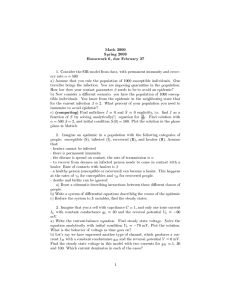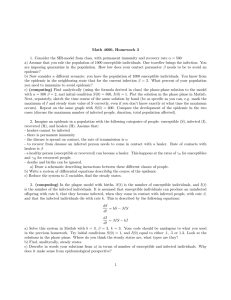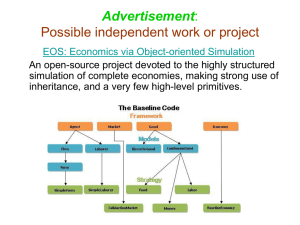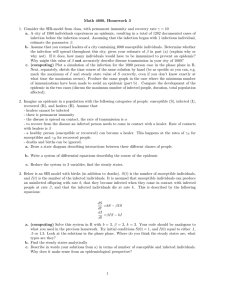EPIDEMIC TECHNIQUES Kaushik Parasam
advertisement
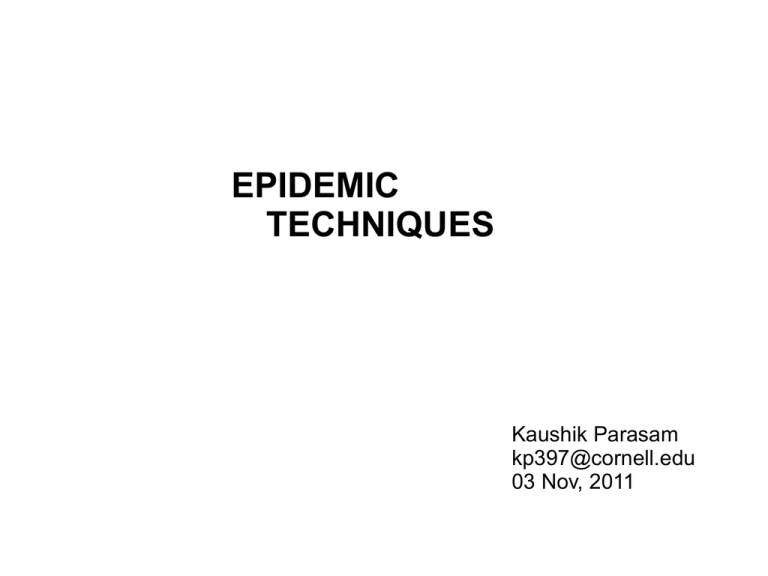
EPIDEMIC TECHNIQUES Kaushik Parasam kp397@cornell.edu 03 Nov, 2011 Epidemics Gossip Communication a.k.a Epidemic protocol, Rumor Spreading Gossip protocol is a style of computer-to-computer communication protocol extensively used in distributed systems Periodic exchange of bounded size messages Pairwise interaction Randomization Eventual consistency k Exponential (1.8 ) spread in log(n) time. Keys to success Simplicity Limited resource usage Robustness to failures Tunable system behavior Where does it fit ? Replication EPIDEMIC ALGORITHMS FOR REPLICATED DATABASE MAINTENANCE Alan Demers, Dan Greene, Carl Hauser, Wes Irish, John Larson, Scott Shenker, Howard Sturgis, Dan Swinehart, and Doug Terry MANAGING UPDATE CONFLICTS IN BAYOU, A WEAKLY CONNECTED REPLICATED STORAGE SYSTEM Doug Terry, Marvin M Theimer, Karin Petersen, Alan Demers, Mike J Spreitzer and Carl Hauser Xerox Palo Alto Research Center Epidemic Algorithms For Replicated Database Maintenance Alan Demers Professor at Cornell University Dan Greene At Xerox PARC – Vehicle networks Carl Hauser Associate Professor, Washington State University Wes Irish Coyote Hill Consulting Scott Shenker Professor at UCBerkeley Doug Terry Microsoft Research John Larson, Howard Sturgis, Dan Swinehart Takeaways Takeaways Novel method – distributed systems Epidemiology works ! Small work, large impact Many implementations down the line... Aggregation in Large Dynamic Networks [1] Kelips: P2P DHT [2] Storage systems [3] T-Man: Fast topology construction [4] and many more ….... Security ? Evaluation ? Not much... Motivation Clearinghouse servers on Xerox Corporate Internet (CIN) Hundreds of ethernets connected by gateways and phone lines Hierarchical name space – domains Remailing - a big overhead V s, s' ϵ S : s.ValueOf = s'.ValueOf The Two Considerations Time required for an update to propogate Network traffic Epidemiology Infective – Knows the update and spreads it Susceptible – Can get infected with the update Removed – Knows the update but not willing to spread it Under the hood Direct Mail – Updates immediately mailed from an entry site to all other sites. - Infected - Susceptible Under the hood Direct Mail – Updates immediately mailed from an entry site to all other sites. Overflow No update received Lacks node topology Message is lost Traffic proportional to the number of sites * average distance between sites - Infected - Susceptible Under the hood Anti-Entropy – Periodically pick a random site and exchange messages Variants: Push IF s.ValueOf.t > s’.ValueOf.t THEN s’.ValueOf <- s.ValueOf Pull IF s.ValueOf.t < s’.ValueOf.t THEN s.ValueOf <- s’.ValueOf Push-pull SELECT TRUE FROM s.ValueOf.t > s’.ValueOf.t => s’.ValueOf <- s.ValueOf s.ValueOf.t < s’.ValueOf.t => s.ValueOf <- s’.ValueOf ENDCASE -> NULL: Under the hood Anti-Entropy - Infected - Susceptible Under the hood Anti-Entropy - Infected - Susceptible Under the hood Anti-Entropy - Infected - Susceptible Under the hood Anti-Entropy - Infected - Susceptible Under the hood Anti-Entropy - Infected - Susceptible Under the hood Anti-Entropy - Infected - Susceptible Under the hood Anti-Entropy: Eventually everyone is infected Efficient and reliable, but propagates slower than direct mail Problems ? Possible Improvements: Checksums Inverted Index Connection Limit, Hunting Under the hood Rumor mongering (Complex epidemic) When a site receives a new update – Hot rumor Periodically choose another site at random to infect other sites If enough number of sites have seen the rumor – Remove Blind vs. Feedback Probability 1/k Depending on receiver Counter vs. Coin Loses interest after k unnecessary contacts Probability on k coin tosses Under the hood Rumor mongering - Infected - Susceptible Under the hood Rumor mongering - Infected - Susceptible Under the hood Rumor mongering Loses interest - Infected Complex epidemic may not converge - Backed up with anti-entropy - Removed - Susceptible Under the hood Death certificates Deletion - harder to manage Usually done with a timestamp Spatial distribution Biased Gossip • Favoring nearby sites over farther ones ? But... • d-a Results with anti-entropy Results with rumor-mongering(push-pull) References: [1] Gossip-based aggregation in large dynamic networks. Márk Jelasity, Alberto Montresor, and Ozalp Babaoglu. ACM Transactions on Computer Systems, 23(3):219–252, August 2005. [2] Kelips: Building an Efficient and Stable P2P DHT Through Increased Memory and Background Overhead. Indranil Gupta, Ken Birman, Prakash Linga, Al Demers, Robbert van Renesse. Proc. 2nd International Workshop on Peer-to-Peer Systems (IPTPS '03) [3] ACM SIGOPS Operating Systems Review - Gossip-based computer networking archive Volume 41 Issue 5, October 2007 [4] T-Man: Gossip-based fast overlay topology construction. Márk Jelasity, Alberto Montresor, and Ozalp Babaoglu. Computer Networks, 53(13):2321–2339, 2009. Revisiting CAP Theorem One-copy serializability Stronger consistency (AP) at stake Weaker consistency Ordering • Vector clocks • Logical clocks Causal Total Ordering - Bayou Managing Update Conflicts in Bayou a Weakly Connected Replicated Storage System Alan Demers Professor at Cornell University Carl Hauser Associate Professor, Washington State University Doug Terry Microsoft Research Marvin Theimer Amazon Web Services Mike Spreitzer IBM, Watson Research Karin Petersen Takeaways Takeaways Application-specific conflict detection, a caveat ? Partial and multi-object updates Stable resolutions Security Not much evaluation results Purpose Mobile, weakly connected Non-real time collaborative applications Bayou Model Clients use Bayou's API's Read-any / write-any Replication by anti-entropy Session guarantees Bayou System model Conflict Detection And Resolution Application-specific Policies to be given by applications to the servers Dependency checks Read-write conflicts detection, a positive Merge procedures Resolve the conflicts Are these an overhead ? More on Bayou Eventual consistency Notion of logical clocks Write stability Commitment Commit procedure Primary commit scheme System Implementation Write log Tuple store Committed / Full views Undo log Access control - D Public-key cryptography, ACCs References: All concepts / results are taken from the following two papers Epidemic algorithms for replicated database maintenance. Alan Demers, et al. Proc. 6th ACM PODC, Vancouver BC, 1987. SOSP '95 Proceedings of the fifteenth ACM symposium on Operating systems principles ACM New York, NY, USA ©1995 / ACM SIGOPS Operating Systems Review Homepage Volume 29 Issue 5, Dec. 3, 1995 Others: http://en.wikipedia.org/wiki/Gossip_protocol Thank You Questions ?

